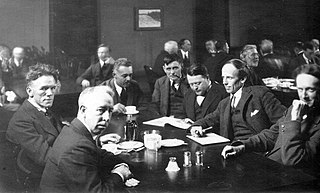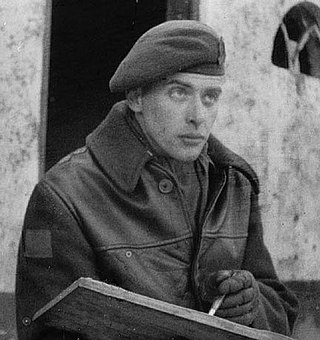
The Group of Seven, once known as the Algonquin School, was a group of Canadian landscape painters from 1920 to 1933, with "a like vision". It originally consisted of Franklin Carmichael (1890–1945), Lawren Harris (1885–1970), A. Y. Jackson (1882–1974), Frank Johnston (1888–1949), Arthur Lismer (1885–1969), J. E. H. MacDonald (1873–1932), and Frederick Varley (1881–1969). A. J. Casson (1898–1992) was invited to join in 1926, Edwin Holgate (1892–1977) became a member in 1930, and Lionel LeMoine FitzGerald (1890–1956) joined in 1932.

Cornelius David Krieghoff was a Dutch-born Canadian-American painter of the 19th century. He is best known for his paintings of Canadian genre scenes involving landscapes and outdoor life, which were as sought after in his own time as they are today. He painted many winter scenes, some in several variants.

Paul-Émile Borduas was a Québecois artist known for his abstract paintings. He was the leader of the avant-garde Automatiste movement and the chief author of the Refus Global manifesto of 1948. Borduas had a profound impact on the development of the arts and of thought, both in the province of Quebec and in Canada.

The following lists events that happened during 1909 in Canada.

Events from the year 1906 in Canada.

Black Canadians, also known as African Canadians or Afro-Canadians, are Canadians of full or partial sub-Saharan African descent. The majority of Black Canadians are of Caribbean and African origin, though the Black Canadian population also consists of African Americans in Canada and their descendants.

David Alexander Colville, LL. D. was a Canadian painter and printmaker.

Maud Kathleen Lewis was a Canadian folk artist from Nova Scotia. She lived most of her life in poverty in a small house in Marshalltown, Nova Scotia. She achieved national recognition in 1964 and 1965 for her cheerful paintings of landscapes, animals and flowers, which offer a nostalgic and optimistic vision of her native province. Several books, plays and films have been produced about her. She remains one of Canada's most celebrated folk artists. Her works are displayed at the Art Gallery of Nova Scotia, as well as her restored house, whose walls she adorned with her art. Despite her recognition, Lewis never had a museum exhibition, nor was her work collected by art galleries or museum during her lifetime.

Silver Donald Cameron was a Canadian journalist, author, playwright, and university teacher whose writing focused on social justice, nature, and the environment. His 15 books of non-fiction dealt with everything from history and politics to education and community development.

John Alexander Douglas McCurdy, was a Canadian aviation pioneer and the 20th Lieutenant Governor of Nova Scotia from 1947 to 1952.

Geof Isherwood is an American painter, sculptor and comic book illustrator.

The history of Nova Scotia covers a period from thousands of years ago to the present day. Prior to European colonization, the lands encompassing present-day Nova Scotia were inhabited by the Mi'kmaq people. During the first 150 years of European settlement, the region was claimed by France and a colony formed, primarily made up of Catholic Acadians and Mi'kmaq. This time period involved six wars in which the Mi'kmaq along with the French and some Acadians resisted British control of the region: the French and Indian Wars, Father Rale's War and Father Le Loutre's War. During Father Le Loutre's War, the capital was moved from Annapolis Royal, Nova Scotia, to the newly established Halifax, Nova Scotia (1749). The warfare ended with the Burying the Hatchet ceremony (1761). After the colonial wars, New England Planters and Foreign Protestants immigrated to Nova Scotia. After the American Revolution, Loyalists immigrated to the colony. During the nineteenth century, Nova Scotia became self-governing in 1848 and joined the Canadian Confederation in 1867.

William McDonald was a Canadian politician.

Canadian art refers to the visual as well as plastic arts originating from the geographical area of contemporary Canada. Art in Canada is marked by thousands of years of habitation by Indigenous peoples followed by waves of immigration which included artists of European origins and subsequently by artists with heritage from countries all around the world. The nature of Canadian art reflects these diverse origins, as artists have taken their traditions and adapted these influences to reflect the reality of their lives in Canada.

William Valentine (1798–1849) was a portrait painter and daguerreotypist in Halifax, Nova Scotia.
Jacques Hurtubise (1939–2014) was a Canadian abstract painter, "known for his abstract, brightly coloured acrylic paintings".
Mary Marguerite Porter Zwicker was a Canadian artist and art promoter from Halifax, Nova Scotia. Known for her watercolor paintings of landscapes and villages in Nova Scotia, Zwicker exhibited her work at the Royal Canadian Academy of Arts, the Montreal Art Association, and the Art Gallery of Nova Scotia. Together with her husband, Leroy Zwicker, she owned and operated Zwicker's Gallery; for most of the 20th century, Zwicker's Gallery was the only Halifax gallery that routinely held art exhibits open to the public. It still operates.
Jean Albert McEwen was a Canadian painter known for his lyrical abstraction.
Edith Hester McDonald-Brown was an African-Canadian artist. She is thought to be the first documented Black female painter in Canadian art history.
Joseph Douglas Purcell was a Canadian artist from Nova Scotia.












